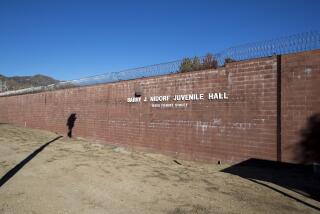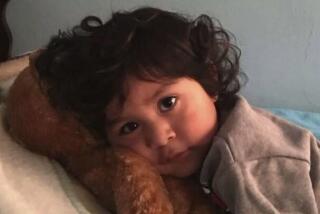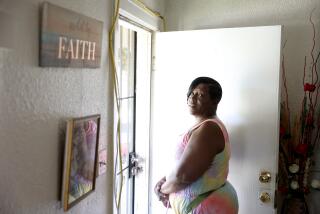Controversy Grows as Bill Redefining Child Abuse Gains
A little-noticed--but suddenly controversial--bill that could greatly curtail authorities’ ability to remove children from homes where child abuse is suspected is moving toward the state Assembly floor, where a vote is expected late this week.
Proponents of the bill, which rewrites sections of the state Welfare and Institutions Code dealing with abused and neglected children, say it would give guidance and direction to social workers, unlike the current laws that they call “antiquated and vague.”
Critics say the bill, SB 243, sponsored by Sen. Robert Presley (D-Riverside), would screen out all but the most seriously and obviously injured children and will cause increasing numbers of abused children to fall through the system’s cracks.
Abuse Redefined
The proposed bill redefines what constitutes abuse, sanctions spanking as a means of discipline, mandates that lawyers be appointed for children and parents in dependency court proceedings, and speeds up the freeing of children for adoption in cases in which they cannot safely be returned to the home after a reasonable length of time.
Currently, the Welfare and Institutions Code describes in five paragraphs the conditions under which a child can be declared a ward of the court, a description that allows judges wide flexibility and discretion. It focuses on homes that are unfit “by reason of neglect, cruelty, depravity or physical abuse.”
Section Would Be Replaced
That section would be replaced by a detailed list of grounds on which a child could be taken into protective custody, such as a finding that the child has suffered or is at “substantial risk” of suffering “serious physical harm inflicted non-accidentally . . . by the parent or guardian.”
“ ‘Serious physical harm’ does not include reasonable and age-appropriate spanking where there is no evidence of harm to bones or internal organs or involvement of the head or facial area or serious visible physical injury to other areas of the body,” it adds.
That spanking provision has enraged many in the child abuse field, who say that “spanking” can range from an occasional swat on the rear to brutal beatings with a belt and that excluding a child from protection until the abuse reaches the level of broken bones or crushed livers is unconscionable.
“The thrust of (the bill) is to make it hard to protect children and to put a shield in front of (possibly abusive) parents by giving them new defenses,” said a high-ranking county child abuse official who asked not to be identified because the county is on record as favoring the measure.
But Jane Henderson, consultant to the Senate Select Committee on Children and Youth, which Presley chairs, defended the bill, calling it an attempt to remedy problems that two earlier child abuse measures sponsored by Presley failed to address.
“It’s intended to clarify which children come into the (dependency court) system, to make sure all have adequate access to services and legal rights and then, if they don’t make it, to eliminate messing around with years of hearings in another court (to terminate parental rights and free a child for adoption),” she said.
Some social workers, however, “are a bit overzealous and would like to be involved in guiding families’ lives,” she said. “They may be well-intentioned, but unnecessary removal (of a child from his parents) is very traumatic.”
Henderson labeled fears that some children will be left in abusive homes “paranoia” and said they are unfounded under a “reasonable reading” of the new measure. She noted that a task force has worked for months to refine the wording and that, after amendments that reflect political compromises, there appears to be little or no opposition to the bill among members of the Legislature.
However, some legislators think the bill needs more study. “The Assembly should not rush to judgment and pass this measure this year,” said Assemblyman Patrick Johnston (D-Stockton), a former juvenile probation officer who said he will recommend holding off on a vote. “It would be better to allow an interim period to revisit the bill and the environment and decide in January.”
The California Consortium of Child Abuse Councils also recommends a delay. “We need to be sure that we keep the gate open for abused children, not risk shutting it by narrowing the definition of those cases that can be considered for court jurisdiction,” said Deanne Tilton, president of the consortium.
Tilton, who is also director of Los Angeles County’s Interagency Council on Child Abuse and Neglect, said child homicides in Los Angeles County rose from 32 in 1985 to 52 in 1986, and suspicious child deaths doubled, from 103 to 203, leading her to conclude that “we are still missing a lot of cases (that need intervention).”
“Even seemingly superficial injuries to infants or very young children can be potentially lethal,” she added, noting that most of the homicides involved children under 2 years old.
According to some child abuse officials who are critical of the bill, some examples of children who might be excluded from protection by the new criteria, include:
- A child molested by the mother’s boyfriend unless it could be proven that the mother knew about it.
- A baby born to a convicted pedophile who is imprisoned but will return home upon release.
- A youngster bruised from beatings but with no evidence of broken bones or other serious injury. Child abuse experts say abuse often escalates from relatively minor spanking to murder and, noted one, “The only way you can diagnose a subdural hematoma is by autopsy.”
- Runaways who have fled abusive homes.
- Victims of the “shaken baby syndrome” (violent shaking of a young child that can result in brain damage or death).
Catherine Tracy, chief deputy director of Los Angeles County’s Department of Children’s Services, denied critics’ charges that her administration supports the bill only because it would reduce heavy caseloads. “It in no way means we will go out to see less children or screen them out of the system,” she insisted. “It does mean we will have to think carefully before we take them into court.
“We’ve got to come up with other alternatives (such as homemaker services, respite care, and parenting training), and the state needs to back those up financially.”
She said under current law, in the absence of specific guidelines, young, inexperienced social workers are often too quick to file petitions to place children under court jurisdiction.
“Sixty per cent of our workers have less than two years’ experience. They get afraid,” Tracy said. “They’d rather err on the side of caution (by removing the child from a possibly unsafe environment). Judges say they are seeing kids they don’t think belong in court, but nobody wants to take a chance.”
County Backers
In Los Angeles County, the legislation has the official support of the Department of Children’s Services and the Los Angeles Superior Court, but is opposed by the juvenile division of the Los Angeles Police Department and many workers who deal daily and directly with abused youngsters.
Last July, the Board of Supervisors voted in favor of the bill “if amended,” but has not restudied the current proposal.
Other groups as philosophically diverse as the Children’s Lobby (a volunteer children’s advisory group) and VOCAL (an organization serving “those falsely accused of child abuse”) have expressed concerns but say they are reserving judgment until they see the bill in its final form.
Part of the controversy appears to stem from confusion about exactly what is in the latest version of the bill and what its impact will be.
A rough draft of the bill began circulating two years ago; a statewide task force has been working on it since January. After the Senate amended and passed the measure two months ago by a vote of 29 to 0, it has been amended at least three more times. Still more amendments are expected this week in the Assembly Ways and Means Committee.
That leads Beth Lowe, chairwoman of the county Children’s Services Commission, to agree with Johnston and others asking for more time to study the measure. “I’d hate to see it rushed through,” she said Friday, “when people haven’t digested it the way they should.”
More to Read
Get the L.A. Times Politics newsletter
Deeply reported insights into legislation, politics and policy from Sacramento, Washington and beyond. In your inbox three times per week.
You may occasionally receive promotional content from the Los Angeles Times.










